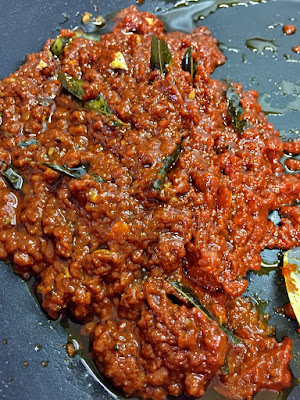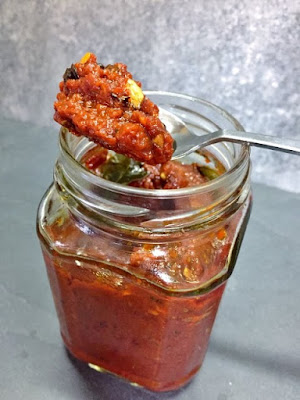I have been trying out new recipes, since one of the people who will be attending cannot eat nuts. So many Indian recipes use nuts in one way or other, even down to grinding them to use as thickeners instead of our method in the US, of thickening with flour or cornstarch. So I finally settled on making a Lamb biryani dish as the main course. I wrote about my biryani, which was heavenly, in my blog post of September 28th. I got all the kinks worked out of the recipe, and have things ordered in such a way as to make it as smooth flowing as possible.
 |
| Mulligatawny, first try |
When I first tried this out, I followed a recipe from a cookbook I found many years ago, called the Bombay Palace Cookbook. In this recipe, the soup calls for the use of ½ pound of besan. Besan is flour made from ground chickpeas. This soup was meant to serve 6 to 8. With that much of the chickpea flour, the whole pot of water seized up into such a thick mass that it became difficult to even stir, much less cook the little red lentils, also in this recipe, through to doneness. I don't know if this was a typo in the recipe, but I will be rectifying that when I recreate this soup. I think in all the myriad recipes I read or watched since, none of them have called for besan flour or even chickpeas. Most seem to use tiny amounts of toor dal (split dried pigeon peas) and/or gram dal, still leaving the finished soup very runny. Some few had a very slight thickening after pureeing, depending on the amount of these beans or lentils used.
After all this, some use curry leaves, some don't. As the actual title is Pepper Water, some do use a fair amount of black peppercorns, but others use just a tiny bit. Some use a lot of chili peppers and some don't. This is another of those recipes that seem to have 100,000 different variations.
My very thick soup was good in flavors, no doubt, but I will be making it differently when I make it for the dinner!
 |
| Allam Pachadi or Ginger Tamarind Pickle |
And then I started wondering about "Indian Pickles." I keep wondering what the Indians mean by "pickle," because their pickles have nothing in common with what I know (upper Midwest U.S. girl) as pickles. The recipe I chose to try today was made with ginger and tamarind. The recipe called for 6 tablespoons of hot red chili powder. This is powdered dried chilies, not the stuff that goes into chili con carne. This is HOT! And 6 tablespoons? Okay, I chose to make half the recipe. I also chose to use 2 tablespoons of Spanish paprika and only 1 tablespoon of the Kashmiri red chili powder I have. I mostly followed the rest of the recipe called Allam Pachadi on a website called Indian healthy recipes. It came out very nicely and while it is hot, it is just tolerable for me. Which means my husband won't touch this with a 10-foot pole, but I know at least a couple of my guests do like hot spice. It looks really pretty, for sure. This is my translation (grams to ounce or tablespoons, sequence of events and so on. Do visit Swasthi's website by clicking on the title above.
Allam Pachadi, Americanized, or Ginger Tamarind Pickle
 |
| Allam Pachadi or Ginger Tamarind Pickle |
½ pound fresh, plump ginger root
6 tablespoons cooking oil, divided
100 grams of tamarind whole (about 8 pods) - or compressed tamarind paste in a
comparable amount
1 cup boiling water
2 tablespoons pure red chili powder
4 tablespoons Spanish paprika
¼ teaspoon turmeric powder
1 teaspoon salt
6 tablespoons palm sugar or brown sugar
1 tablespoon fenugreek powder
1 teaspoon brown mustard seeds
4 -6 cloves garlic, smashed
20 to 24 fresh curry leaves
2 dried red chilies, broken
⅛ teaspoon asafoetida
Soak the tamarind in 1 cup boiling water for about 20 minutes.
Peel the ginger and slice thinly, then rough chop. Heat a skillet and use about 1 tablespoon of the oil to fry the ginger until it starts to brown, about 5 to 7 minutes. Set aside to cool completely. Once cooled, place in the food processor and process very fine.
Set a sieve over a bowl. Lift out one of the soaked tamarind pods at a time. Using hands, roll and press the flesh from the seeds and fibers, pressing the puree into the bowl. If a little water is needed, add only enough to rinse down. You want tamarind puree, not a liquid. I got about 6 tablespoons of paste. Add this to the ginger in the processor, along with the paprika and chili powders, turmeric and salt. Process to combine. Add in the palm sugar (jaggery) or brown sugar and the fenugreek powder and process again to combine. Taste for flavor. It should be balanced between sour/sweet/hot/spicy. If not, adjust to taste.
Heat the remaining oil in a skillet. Once hot, add in the mustard seeds and stir until they begin to pop. Add in the garlic, curry leaves and asafoetida and stir until the curry leaves are crisp. Remove the pan from the heat. Scrape in the ginger paste mixture and stir to combine all the ingredients. Use all the oil, as it will surface and preserve the mixture for longer. Store in a glass jar, not in plastic.
It will easily stay in the refrigerator for a year, according to Swasthi's recipe.
NOTE: in the original recipe, it is stated that if desired one can add in a teaspoon each of Urad Dal and Channa Dal when frying the mustard seeds. I happened to have both, so I did this. They are toasted in the oil, and supposedly soften in the mixture as it sets.
My passion is teaching people how to create a harmony of flavors with their cooking, and passing along my love and joy of food, both simple or exotic, plain or fancy. I continue my journey in ethnic and domestic cuisines, continuing my journey to explore diverse culinary experiences and hopefully to start you on a journey of your own. Join me also at A Harmony of Flavors on Facebook, and Pinterest.

No comments:
Post a Comment